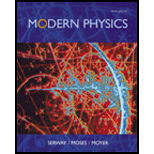
Concept explainers
The four fundamental interactions and the field particle that mediates each.
Answer to Problem 1Q
The four fundamental interactions are strong interaction carried by gluon, the weak interaction carried by W and Z bosons,
Explanation of Solution
The fundamental interactions are also known as fundamental forces. They are the interactions that do not appear to be reducible to more basic interactions. Each of the interaction can be described mathematically as a field. The four fundamental interactions are gravitational force, electromagnetic force, weak force and strong force.
The gravitational force is a long-range force and is described by general theory of relativity. The gravitational interaction is mediated by gravitons. Electromagnetic force is also a long-range interaction. They create electric and magnetic fields and are carried by photons. Weak interaction is a short-range force and act on nucleus of atoms. They are carried by W and Z bosons. Strong interactions are responsible to bind quarks together. They are mediated by gluons.
Conclusion:
Thus, the four fundamental interactions are strong interaction carried by gluon, the weak interaction carried by W and Z bosons, electromagnetic interaction mediated by photon and gravitational interaction carried by graviton.
Want to see more full solutions like this?
Chapter 15 Solutions
Modern Physics
- Each of the following reactions is missing a single particle. Identify the missing particle for each reaction. p+pn+? p+pp+0+? ?+p+? K+n0+? +e++ve+? (f)ve+pn+?arrow_forwardCheck Your Understanding What is the baryon number of a pion?arrow_forwardWhich particles are categorized as Baryons?arrow_forward
- Two ions containing a total of 98 protons, 59 electrons, & 126 neutrons are smashed together at the LHC (Large Hadron Collider). The aftermath of the collision contains neutrinos, neutrons, protons, & electrons. After the collision physicists detect 108 neutrinos, 28 neutrons, & 104 electrons. According to the Law of Conservaton of Charge, how many protons must also be present? number of protons present after collision =arrow_forwardA proton is made of which 3 types of quarks? Group of answer choices A: UP - DOWN - DOWN B: UP - TOP - DOWN C: UP - UP - UP D: UP - DOWN - CHARM E: UP - UP - DOWN F: DOWN - UP - DOWNarrow_forwardWhich ones of the following are properties of charged and neutral weak interactions? They are transmitted by vector bosons which can interact among themselves. They are transmitted by heavy vector bosons. They do not conserve the combined symmetry CP. They always conserve parity. They do not always conserve flavor.arrow_forward
- Match these particle physics descriptions A class of particles that consist of two quarks An electron is a member of this class of particles. A proton is a member of this class of particles A class of particles that experiences the weak but not the strong nuclear force. A class of particles that consist of three quarks A class of particles that experiences strong and weak nuclear forces. 1. Hadrons 2.Mesons 3.Baryons 4.Leptonsarrow_forwardWhat is the numeric answer to problem #32?arrow_forwardAs a multiple of e1 what is the charge q1 of the particle that is composed of the quark combination udd? q1 = ? e As a multiple of e1 what is the charge q2 of the particle that is composed of the quark combination dds? q2 = ? earrow_forward
 Modern PhysicsPhysicsISBN:9781111794378Author:Raymond A. Serway, Clement J. Moses, Curt A. MoyerPublisher:Cengage Learning
Modern PhysicsPhysicsISBN:9781111794378Author:Raymond A. Serway, Clement J. Moses, Curt A. MoyerPublisher:Cengage Learning Principles of Physics: A Calculus-Based TextPhysicsISBN:9781133104261Author:Raymond A. Serway, John W. JewettPublisher:Cengage Learning
Principles of Physics: A Calculus-Based TextPhysicsISBN:9781133104261Author:Raymond A. Serway, John W. JewettPublisher:Cengage Learning University Physics Volume 3PhysicsISBN:9781938168185Author:William Moebs, Jeff SannyPublisher:OpenStax
University Physics Volume 3PhysicsISBN:9781938168185Author:William Moebs, Jeff SannyPublisher:OpenStax Glencoe Physics: Principles and Problems, Student...PhysicsISBN:9780078807213Author:Paul W. ZitzewitzPublisher:Glencoe/McGraw-Hill
Glencoe Physics: Principles and Problems, Student...PhysicsISBN:9780078807213Author:Paul W. ZitzewitzPublisher:Glencoe/McGraw-Hill College PhysicsPhysicsISBN:9781285737027Author:Raymond A. Serway, Chris VuillePublisher:Cengage Learning
College PhysicsPhysicsISBN:9781285737027Author:Raymond A. Serway, Chris VuillePublisher:Cengage Learning College PhysicsPhysicsISBN:9781305952300Author:Raymond A. Serway, Chris VuillePublisher:Cengage Learning
College PhysicsPhysicsISBN:9781305952300Author:Raymond A. Serway, Chris VuillePublisher:Cengage Learning





